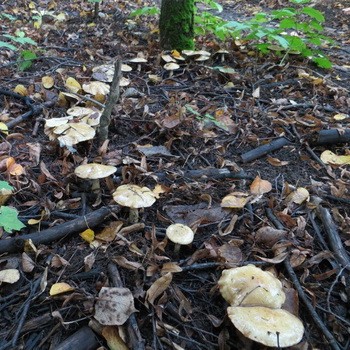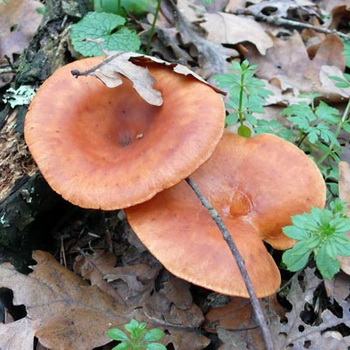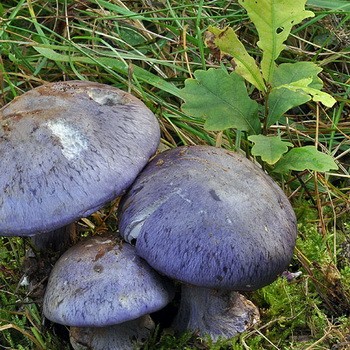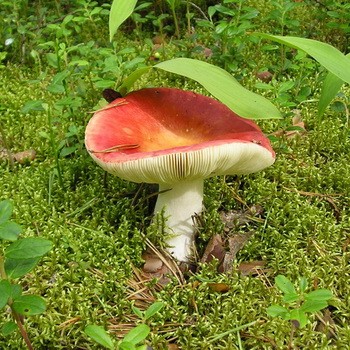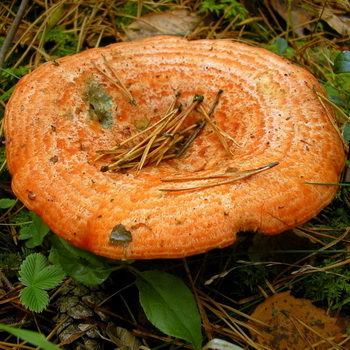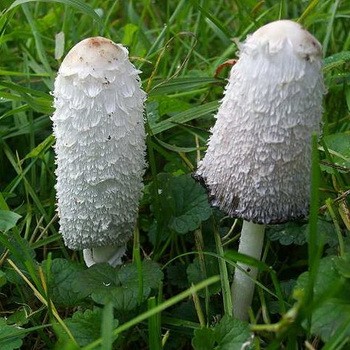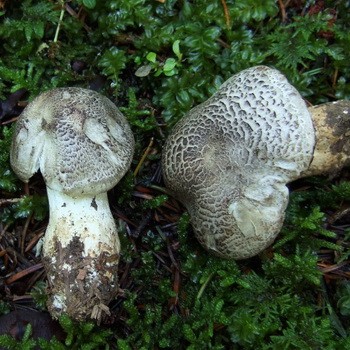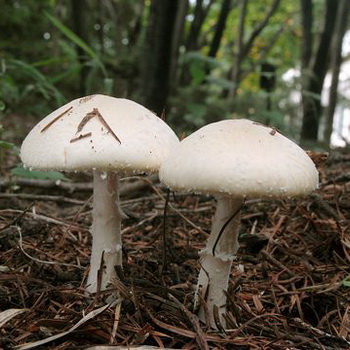Marshmallows and how edible mushrooms look

In this article you will see photos of edible rows of various species (yellow-red, gray, violet, pigeon and violet), give a description of them, and tell you where they grow.
Content
Mushroom Ryadovka yellow-red and his photo
Category: edible
Hat Tricholomopsis rutilans (diameter 6-17 cm) yellow-red, with reddish scales, convex. Over time, changes shape to almost flat. To the touch velvety, dry.
Leg of yellow-red rowing (height 5-12 cm): hollow and curved, with fibrous scales along the entire length and a noticeable thickening at the very base. The color is similar to a hat.
Records: sinuous, bright lemon or deep yellow.
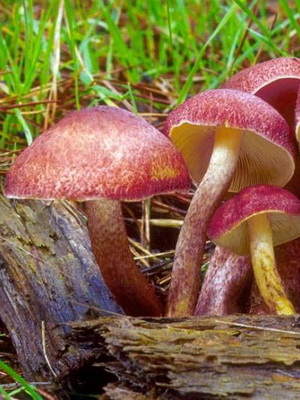

Pay attention to the photo of the yellow-red rowing: its flesh is the same color as the plates. It has a bitter taste, it smells of rotten wood.
Doubles: are absent.
When growing: from mid-July to the end of October in the temperate zone of Russia.
Where to find: in coniferous forests on rotten stumps and dead wood.
Eating: mainly young mushrooms in salted or pickled form, subject to preliminary boiling.
Application in traditional medicine: not applicable.
Other names: pine honey agaric, blushing row, yellow-red honey agaric, false-yellow-red, red honey agaric.
Edible gray rowade: photo and description (Tricholoma portentosum)
Category: edible.
Hat (diameter 3-13 cm): usually grayish, less often with a purple or olive tint, in the center more intense, with a pronounced tubercle. Convex or conical, with time it becomes prostrate, in old mushrooms it turns up. The edges are usually uneven and wavy or covered with cracks, bend to the inside. In wet weather, slippery, often with adhering particles of earth or grass.
Leg (height 4.5-16 cm): white or yellowish, usually with a powdery coating. Thickened at the base, solid and fibrous, hollow in old mushrooms.
Records: sinuous, white or yellowish.
Pulp: dense and fibrous, the same color as the plates. It does not have a pronounced aroma.

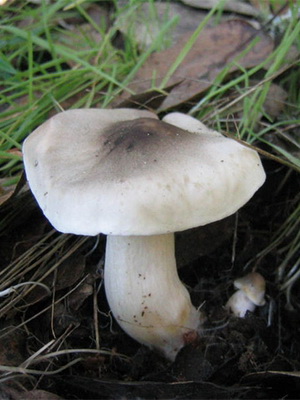
The photo and description of the edible gray row is similar to the poisonous variety of the mushroom, so care must be taken when picking mushrooms.
Doubles: earthy rowing (Tricholoma terreum), which is smaller and has small scales on the hat. Soap row (Tricholoma saponaceum) is easily distinguished by the smell of laundry soap at the cut site.The poisonous rowan of pointed (Tricholoma virgatum) has a burning taste, on an ash-white hat there is a gray sharp tubercle. And the rowan is different (Tricholoma sejunctum), which belongs to the conditionally edible group, has an extremely unpleasant odor and a greenish tint to the legs.
When growing: from late August to mid November in temperate northern hemisphere countries.
Eating: the mushroom is tasty in any form, only it is first necessary to remove the skin and rinse it thoroughly. After cooking, the color of the pulp often darkens. For culinary purposes, mushrooms of various ages are suitable.
Application in traditional medicine (data not confirmed and not passed clinical trials!): in the form of tincture. It has antibiotic properties.
Where can I find: on coniferous or mixed sandy soils
Other names: streaky streak, sub-basement, undergrowth.
Mushroom rowovka purple: photo and description
Category: conditionally edible.
Mushroom hat ryadovka violet (Lepista nuda) (diameter 5-22 cm): purple with varying degrees of intensity, noticeably fades, especially at the edges, in old mushrooms it becomes brownish-ocher. Fleshy and large. The shape of the hemisphere gradually changes to open, strongly depressed or funnel-shaped. The edges of the mushroom cap are noticeably bent toward the inside. On feel smooth, without tubercles or cracks.

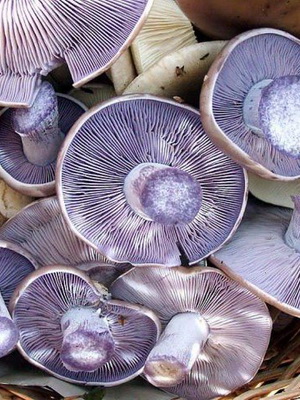
Look at the photo of the purple row: the mushroom has a smooth, dense stalk 5-12 cm high. Basically, the stalk is longitudinally fibrous; in old mushrooms it can become hollow. It has a cylindrical shape, under the hat itself - a flaky coating, and at the very base - a purple mycelium. Narrows from bottom to top. Over time, it significantly brightens from bright purple to gray-lilac and light brown.
Records: the young mushroom is wide and thin, with a purple-violet hue, fade over time and acquire a brown hue. Markedly behind the legs.
Pulp: light purple and very soft, the smell is similar to anise.
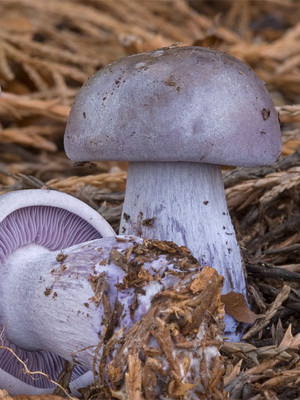
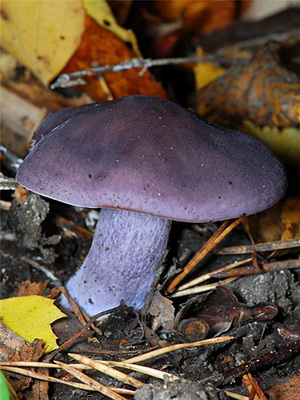
The photo and description of the violet rowan is similar to the violet rowan variety.
Doubles:earthy rowfish (Tricholoma terreum), which is smaller and has small scales on the hat. Soap row (Tricholoma saponaceum) is easily distinguished by the smell of laundry soap at the cut site. The poisonous rowan of pointed (Tricholoma virgatum) has a burning taste, on an ash-white hat there is a gray sharp tubercle. A row is different (Tricholoma sejunctum), which refers to the conditionally edible group, has an extremely unpleasant odor and a greenish tint to the legs.
When growing: from mid-August to early December in temperate northern hemisphere countries.
Where can I find: on the litter of coniferous and mixed forests mainly next to oaks, spruces or pines, often on heaps of compost, straw or brushwood. Forms “witch circles”.
Eating: after heat treatment in any form. It is very fried and boiled, so the best option is drying.
Application in traditional medicine (data not confirmed and not passed clinical trials!): as a diuretic.
Important! Since the purple ranks belong to the category of saprophytes, they should never be eaten raw. Such carelessness can result in serious stomach upsets.
Other names: titmouse, naked lepista, cyanosis, purple lepista.
What else are the lineups: pigeon and violet
Pigeon row (Tricholoma columbetta) – edible mushroom.
Hat (diameter 5-12 cm): white or grayish, may be with green or yellow spots. Fleshy, often with wavy and cracked edges. In young mushrooms, it has the shape of a hemisphere, which over time changes to a more open. The surface in wet weather is very sticky.
Leg (height 6-11 cm, diameter 1-3 cm): often curved, white, may be greenish at the base.
Records: wide and frequent. Young mushrooms are white, while adults are reddish or brown.
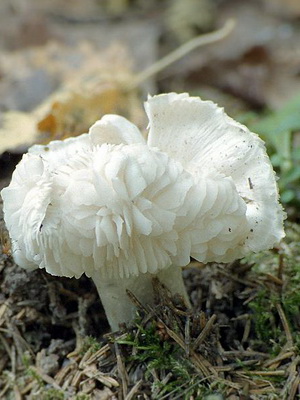
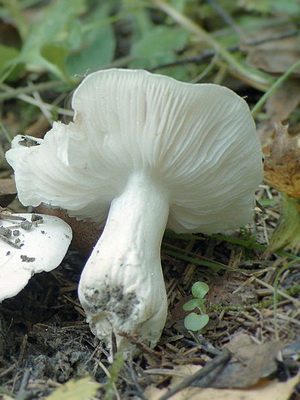
As can be seen in the photo of the edible mushroom, the flesh, the flesh of this species is very dense, it turns slightly pink at the place of the cut.It produces a distinct floury smell.
Doubles: inedible white rowfish (Tricholoma album) with a brown base of the leg and an extremely unpleasant odor.
When growing: from the beginning of August to the end of September in temperate countries of the Eurasian continent.
Where can I find: in deciduous and mixed forests. It can grow in open spaces, in particular in pastures or meadows.
Eating: the mushroom is suitable for pickling and pickling. Under the influence of high temperatures during the heat treatment, the flesh of the rower turns red, but this does not affect its taste.
Application in traditional medicine: not applicable.
Other names: bluish rowing.
Ordinary violet (Lepista irina) also belongs to the category of edible mushrooms.

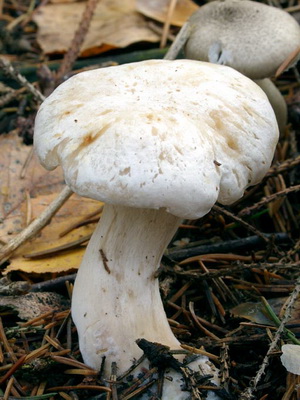
Hat (diameter 3-14 cm): usually white, yellowish or brown. In young mushrooms, it has the shape of a hemisphere, which eventually changes to almost flat. The edges are uneven and wavy. The touch is smooth.
Leg of violet rowing (height 3-10 cm): slightly lighter than cap, tapering from bottom to top. Fibrous, sometimes with small scales.
Pulp: very soft, white or slightly pinkish, without a pronounced taste, it smells of fresh corn.
Doubles: smoky talker (Clitocybe nebularis), which has large sizes and very wavy edges.
When growing: from mid-August to early November in temperate northern hemisphere countries.
Where can I find: in mixed and deciduous forests.
Eating: subject to preliminary heat treatment.
Application in traditional medicine: not applicable.
